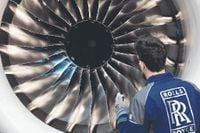Rolls-Royce Holdings plc has regained its footing in the stock market, with shares climbing back to over 700p, resulting in a market capitalisation exceeding £60 billion. This resurgence comes in the wake of a tumultuous period triggered by President Donald Trump’s tariff announcements, which previously sent shockwaves through global markets.
Initially, shares of the Derby-based engineering giant were trading above 800p before the tariffs were announced, leading to a steep decline that saw prices plummet to a low of 635p. However, following a brief recovery, the company has seen its stock price rise significantly, marking a more than 620% increase over the past three years. This remarkable recovery can be attributed to various factors, including a recent defence summit in London that underscored European leaders' commitment to support Ukraine and increase defence spending.
At the summit, held in early March 2025, the announcement of enhanced military budgets across Europe provided a boost to Rolls-Royce’s share price, which surged from just over 600p to more than 800p in a matter of days. However, the optimism was short-lived as the market reacted negatively to Trump’s tariff announcement at the start of April, leading to fears of a potential global trade war. This caused the FTSE 100 group to lose more than £10 billion in value.
Despite this setback, Rolls-Royce has begun to recover, buoyed by a proposal at the end of February to reinstate a 6p per share dividend for investors—its first payout since the pandemic began. The company reported a revenue of £17.8 billion, surpassing analysts' expectations of approximately £17.3 billion. This positive financial performance, however, comes amidst a broader market decline, as the FTSE 100 fell by seven points at the open on April 22, 2025, following a significant downturn in US markets.
The S&P 500, for instance, closed down 2.38% at 5,158 on April 21, 2025, while both the Nasdaq and Dow Jones also experienced substantial losses of 2.5% and 2.48%, respectively. These declines reflect ongoing instability in the market, further exacerbated by Trump’s continued criticism of Federal Reserve Chair Jerome Powell, whom he described as “a major loser.”
While Rolls-Royce's stock has shown signs of recovery, analysts caution that the company’s current price-to-earnings (P/E) ratio has risen above 23, nearly double the FTSE 100 average. This situation raises concerns regarding the sustainability of further growth unless the company can demonstrate significant improvements in earnings. CEO Tufan Erginbilgiç has been credited with leading the company through its recovery, but some analysts believe that potential investors may have missed the optimal buying opportunity.
In contrast, BAE Systems, another prominent player in the defence sector, presents a different investment narrative. The company reported a record £37.7 billion in new orders in 2023, increasing its total order backlog to £69.8 billion. BAE's business model, which relies on long-term government contracts, provides a level of stability that is often absent in the more volatile commercial aviation sector that Rolls-Royce operates in.
BAE trades at a more reasonable forward P/E ratio of around 17, offering a compelling investment case for those seeking steady growth. The company has also demonstrated a consistent commitment to shareholder returns, boasting a compound annual growth rate of 7.3% in dividends over the past five years, with a current yield of around 2%. This financial strength positions BAE favorably as governments worldwide, including the UK, US, and European nations, ramp up military spending in response to ongoing global conflicts.
Moreover, BAE’s strategic focus on emerging technologies such as cyber defence and AI-driven military systems aligns well with future demand, further enhancing its growth potential. While Rolls-Royce has delivered impressive returns for early investors, its current valuation leaves little room for error, prompting some analysts to recommend BAE as a more prudent choice for long-term investors.
In summary, while Rolls-Royce has made significant strides in recovering from its recent lows, the volatility in its stock price and the high P/E ratio may deter potential investors. On the other hand, BAE Systems offers a more stable investment opportunity, backed by strong order growth and a reliable dividend track record. As the global landscape continues to evolve, the defence sector remains a critical area of focus, with both companies vying for a share of the growing military budgets.





